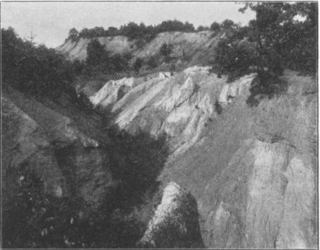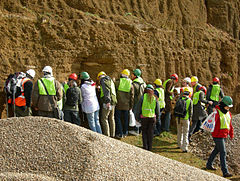
Faringdon is a historic market town in the Vale of White Horse, Oxfordshire, England, 18 miles (29 km) south-west of Oxford, 10 miles (16 km) north-west of Wantage and 12 miles (19 km) east-north-east of Swindon. It extends to the River Thames in the north; the highest ground is on the Ridgeway in the south. Faringdon was Berkshire's westernmost town until the 1974 boundary changes transferred its administration to Oxfordshire. The civil parish is formally known as Great Faringdon, to distinguish it from Little Faringdon in West Oxfordshire. The 2011 Census gave a population of 7,121; it was estimated at 7,992 in 2019. On 1 February 2004, Faringdon became the first place in south-east England to be awarded Fairtrade Town status.

Greensand or green sand is a sand or sandstone which has a greenish color. This term is specifically applied to shallow marine sediment that contains noticeable quantities of rounded greenish grains. These grains are called glauconies and consist of a mixture of mixed-layer clay minerals, such as smectite and glauconite. Greensand is also loosely applied to any glauconitic sediment.
The Kellaways Formation is a geological formation of the Callovian Series from the Jurassic. It is found in the British Isles, immediately above the Great Oolite Series: below the Oxford Clay Formation and above the Cornbrash. It consists of two layers, the Kellaways Sand, a light green-grey clayish silt and sand with layers of sand concretions, overlying the Kellaways Clay, a dark grey plastic fissile clay.
The Reading Formation is a geologic formation in southern England. It dates to the Paleocene period, and is part of the Lambeth Group. It overlies the London Basin and is below the Harwich Formation. The formation is composed of "a series of lenticular mottled clays and sands, here and there with pebbly beds and masses of fine sand converted into quartzite. These beds are generally unfossiliferous."
The Lias Group or Lias is a lithostratigraphic unit found in a large area of western Europe, including the British Isles, the North Sea, the Low Countries and the north of Germany. It consists of marine limestones, shales, marls and clays.

The Lower Greensand Group is a geological unit present across large areas of Southern England. It was deposited during the Aptian and Albian stages of the Early Cretaceous. It predominantly consists of sandstone and unconsolidated sand that were deposited in shallow marine conditions.

The Northampton Sand Formation, sometimes called the Northamptonshire Sand, is a Middle Jurassic geological formation which is placed within the Inferior Oolite Group. It was formerly worked extensively in Northamptonshire for its ironstone.

The Patuxent Formation is a Cretaceous geologic formation of the Atlantic coastal plain.
The Winona Formation is a sand geologic formation in Mississippi. It preserves fossils dating back to the Paleogene period.
The Weches Formation is a greensand, slay, and shale geologic formation in Louisiana and Eastern Texas. It preserves fossils dating back to the Paleogene period, specifically the Eocene.
The Tarratine Formation is a geologic formation in Maine. It preserves fossils dating back to the Devonian period.
The White Bluff Formation is a marl, sand, and clay geologic formation in Arkansas that is part of the Jackson Group. It preserves fossils dating back to the Paleogene period, specifically the Eocene.

The Blanco Formation, originally named the Blanco Canyon Beds, is an early Pleistocene geologic formation of clay, sand, and gravel whitened by calcium carbonate cementation and is recognized in Texas and Kansas.

The Etchegoin Formation is a Pliocene epoch geologic formation in the lower half of the San Joaquin Valley in central California.
The Durlston Formation is a geologic formation in England. Particularly in the Isle of Purbeck. It preserves fossils dating back to the Berriasian stage of the Lower Cretaceous.
The Fullers Earth Formation is a geological formation that outcrops in southern England. It is also mostly present in the subsurface of the Wessex Basin and offshore in the English Channel Basin, Celtic Sea Basin and St George's Channel Basin. It preserves fossils dating back to the Bathonian stage of the Middle Jurassic series such as the pterosaur Dolicorhamphus. It is the lateral equivalent of the Rutland Formation, Sharp's Hill Formation, Calcaire d’Ecouché, and Calcaire de Caen

The Coralline Crag Formation is a geological formation in England. It is a series of marine deposits found near the North Sea coast of Suffolk and characterised by bryozoan and mollusc debris. The deposit, whose onshore occurrence is mainly restricted to the area around Aldeburgh and Orford, is a series of bioclastic calcarenites and silty sands with shell debris, deposited during a short-lived warm period at the start of the Pliocene Epoch of the Neogene Period. Small areas of the rock formation are found in locations such as Boyton and Tattingstone to the south of Orford as well as offshore at Sizewell.

The Corallian Group or Corallian Limestone is a geologic group in England. It is predominantly a coralliferous sedimentary rock, laid down in the Oxfordian stage of the Jurassic. It is a hard variety of "coral rag". Building stones from this geological structure tend to be irregular in shape. It is often found close to seams of Portland Limestone. It is a younger limestone than its near-neighbour, the Oolitic, as found in the Cotswolds, in Gloucestershire. It is laterally equivalent to and interfingers with units of the Ancholme Group.
The Horsehay Sand Formation is a geological formation in England. Part of the Great Oolite Group, it was deposited in the Bajocian to Bathonian stages of the Middle Jurassic, the lithology consists of weakly cemented sand and sandstone, with thin interbeds of mudstone and siltstone. Rootlets and lignitic debris are common. It is the lateral equivalent of the Chipping Norton Limestone and the lower part of the Rutland Formation
The Portland Sand Formation is a limestone formation from the Tithonian stage of the Jurassic period on the Isle of Portland, Dorset, England. The formation is made up largely of dolomites but includes siltstones and fine-grained sandstones in its lower parts. It is a sub unit of the Portland Group.









